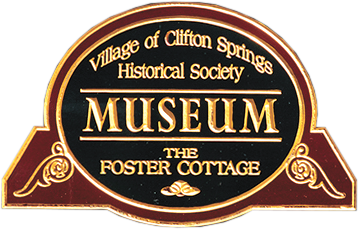Prehistoric Iroquois Settlement, Excavation at the Clifton Springs Site.
Part 6
CONCLUSIONS
From our survey and excavations at Clifton Springs it is clear that we are studying the remains of a small prehistoric Iroquois community,
probably consisting of a few houses of the general longhouse type. The occupants were clearly concerned with defense, as is indicated by
the terrain on which the site lies. The site must have offered extremely favorable conditions, being near the constant water supply of
Sulphur Creek, and the fishing resources of Canandaigua Outlet. Thus it was occupied for a lengthy period, as is indicated by deep hillside
midden accumulations, and at least one phase of village rebuilding.
All of the non-pottery artifacts are typically Iroquoian and would be at home on most prehistoric Iroquois sites in New York. The ceramics,
however, allow us to see more specific relationships with other known prehistoric Iroquois groups. Ceramically, the closest similarity is
with the material from the Belcher site, located about 25 miles westsouthwest. The major ceramic element at Clifton Springs, i.e., medium to
high collars bearing oblique or opposed motifs, is very similar to the bulk of material from Belcher, and I would suggest that the two sites
were occupied more or less contemporaneously. Both sites are ceramic ally related to the prehistoric Iroquois (probably Cayuga) sites
scattered through the hills above the east side of Cayuga Lake. Though MacNeish thought that this indicated that Belcher, and the nearby
Reed Fort or Richmond Mills site, were proto-Cayuga, I do not think that we need conclude this solely on the basis or ceramic similarities.
Clearly, from the Cayuga area westward to the Genesee region, there was a general ceramic tradition of medium to high collars with broad incised
triangular and opposed motifs, just as in central and eastern New York there was a mare or less contemporaneous tradition producing ceramics of
the Chance Incised type. MacNeish believed that the Richmond Mills site was later than Belcher, on the basis of ceramic serrations (Mactleish 1952 : 47).
This conclusion is further reinforced by the large size of Richmond Mills. The pottery from the latter site is in basis conception similar to that
from Belcher and the major pottery style at Clifton Springs, but it gives the general impression of greater thickness and boldness of execution,
as does late prehistoric Mohawk and Onondaga ware over preceding Chance Phase ware (see Ritchie 1965 : 320 and Tuck 1971 : 140). While Clifton
Springs shares, ceramic ally, much with Belcher and Richmond Mills, it also has a lesser, though still significant, ceramic element, which is
almost non-existent in the samples from the latter two sites--the low collar rims with horizontal incising. This style has its nearest parallel
in the material from the prehistoric Iroquois sites in the Bristol Hills area, some 15-20 miles southwest of Clifton Springs. At the Bristol Hills
sites, which have been the subject of intensive study by the Rochester Museum and Science Center (Hayes 1963), Ontario Horizontal, to use MacNeish's
terminology, is the major ceramic type. Such sites as Can 29-3 and Andrews are most likely of the sane general time period as Clifton Springs, showing
no transitional corded collar types, and yet being almost certainly well before the proto-historic period.
It is clear that more detailed work must be done before the pattern of prehistoric
Iroquois village communities and their development into the proto-historic tribal communities in the western Finger Lakes area becomes clear.
However, it seems likely from the ceramic evidence, that the Clifton Springs site was one of a number of Iroquois communities in the region
during perhaps the second half of the 15th century.
From ceramic evidence and geographical distribution, it appears possible that these villages were, before perhaps 1500 or so, unconsolidated
into firm tribal groups, and that they perpetuated differing Iroquois ceramic traditions. The Clifton Springs village seems to have been
related to the tradition producing the ceramic style which MacKeish called Richmond Incised, and to the Bristol Hills tradition which is
characterized by the low collared Ontario Horizontal type.
This is speculative, and much work needs to be carried out on sites in the region in order to clarify the nature of this relationship.
